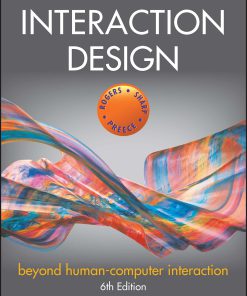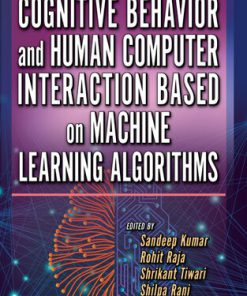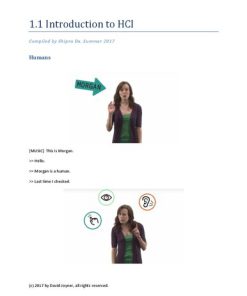Personalized Human Computer Interaction 2nd Edition by Mirjam Augstein, Eelco Herder,Wolfgang Worndl 3110999609 9783110999600
$50.00 Original price was: $50.00.$25.00Current price is: $25.00.
Personalized Human Computer Interaction 2nd Edition by Mirjam Augstein, Eelco Herder,Wolfgang Worndl – Ebook PDF Instant Download/Delivery: 3110999609, 9783110999600
Full download Personalized Human Computer Interaction 2nd Edition after payment
Product details:
ISBN 10: 3110999609
ISBN 13: 9783110999600
Author: Mirjam Augstein, Eelco Herder, Wolfgang Wörndl
Personalized and adaptive systems employ user models to adapt content, services, interaction or navigation to individual users’ needs. User models can be inferred from implicitly observed information, such as the user’s interaction history or current location, or from explicitly entered information, such as user profile data or ratings. Applications of personalization include item recommendation, location-based services, learning assistance and the tailored selection of interaction modalities. With the transition from desktop computers to mobile devices and ubiquitous environments, the need for adapting to changing contexts is even more important. However, this also poses new challenges concerning privacy issues, user control, transparency, and explainability. In addition, user experience and other human factors are becoming increasingly important. This book describes foundations of user modeling, discusses user interaction as a basis for adaptivity, and showcases several personalization approaches in a variety of domains, including music recommendation, tourism, and accessible user interfaces.
Personalized Human Computer Interaction 2nd Table of contents:
Part I Foundations of personalization
Mark P. Graus, Bruce Ferwerda 1 Theory-grounded user modeling for personalized HCI
1.1 Introduction
1.2 Psychological models in personalization
1.3 The relationship between psychological traits and online behavior
1.4 Automated inference of psychological traits or styles
1.5 Incorporating psychological models in personalized systems
1.6 Combining trait inference and trait-based personalization
1.7 Conclusion
Jürgen Ziegler, Benedikt Loepp 2 User-centered recommender systems
2.1 Introduction
2.2 Presentation and visualization of recommendations
2.3 Preference elicitation and interactive control
2.4 Explaining recommendations
2.5 Evaluation of recommender systems
2.6 Summary and future directions
Markus Schedl, Elisabeth Lex 3 Fairness of information access systems
Acknowledgement
3.1 Introduction
3.2 Biases and fairness
3.3 Methods to mitigate harmful bias
3.4 Conclusions and open challenges
Part II User input and feedback
Mirjam Augstein, Thomas Neumayr 4 Personalization and user modeling for interaction processes
4.1 Introduction
4.2 Approach and methodology
4.3 Application areas of personalized interaction
4.4 Discussion and conclusions
Tobias Moebert, Jan N. Schneider, Dietmar Zoerner, Anna Tscherejkina, Ulrike Lucke 5 How to use socio-emotional signals for adaptive training
Acknowledgement
5.1 Introduction
5.2 The concept of emotions and human emotion recognition
5.3 Adaptivity on the example of the training of emotion recognition
5.4 The emotional state of the learner as a supporting parameter for adaptivity
5.5 Discussion
5.6 Conclusion
Dietmar Jannach, Michael Jugovac, Ingrid Nunes 6 Explanations and user control in recommender systems
6.1 Introduction
6.2 Explanations in recommender systems
6.3 Putting the user into control
6.4 Summary and future directions
Eelco Herder, Claus Atzenbeck 7 Feedback loops and mutual reinforcement in personalized interaction
7.1 Introduction
7.2 Computer-supported human decision-making
7.3 Mutual reinforcement in classical user modeling and HCI
7.4 Everyday recommendations from commercial providers
7.5 Integrating conscious decision-making into the interface
7.6 Discussion and future perspectives
Part III Personalization purposes and goals
Julio Abascal, Olatz Arbelaitz, Xabier Gardeazabal, Javier Muguerza, Ainhoa Yera 8 Personalizing the user interface for people with disabilities
Acknowledgement
8.1 Introduction
8.2 User modeling and personalized interaction for people with disabilities
8.3 Evolution and types of interface personalization for people with disabilities
8.4 Data collection and analysis for user modeling
8.5 User interface personalization for specific applications
8.6 Impact of interface personalization on the privacy of users with disabilities
8.7 Conclusions
Judith Masthoff, Julita Vassileva 9 Personalized persuasion for behavior change
9.1 Introduction
9.2 Theories
9.3 Behavior change frameworks and techniques and personalization
9.4 Application domains
9.5 Evaluation
9.6 Ethical issues of personalized persuasion
9.7 Summary and outlook
Chiara Luisa Schleu, Mirjam Augstein 10 Personalization approaches for remote collaborative interaction
Acknowledgement
10.1 Introduction
10.2 Background literature
10.3 Qualitative study
10.4 Thematic coding and taxonomy
10.5 Design implications
10.6 Discussion and conclusion
Appendix A Taxonomy
Part IV Personalization domains
Peter Knees, Markus Schedl, Bruce Ferwerda, Audrey Laplante 11 Listener awareness in music recommender systems: directions and current trends
Acknowledgement
11.1 Introduction
11.2 Relevant factors in music recommendation
11.3 Correlates of music preferences
11.4 Contextual and situational music listening behavior
11.5 Music information behavior
11.6 User-centric evaluation of music recommender systems
11.7 Conclusions
Daniel Herzog, Linus W. Dietz, Wolfgang Wörndl 12 Tourist trip recommendations – foundations, state of the art and challenges
12.1 Introduction
12.2 The tourist trip design problem
12.3 State of the art in tourist trip recommendations
12.4 Current and future challenges
12.5 Conclusions
Wilfried Grossmann, Mete Sertkan, Julia Neidhardt, Hannes Werthner 13 Pictures as a tool for matching tourist preferences with destinations
13.1 Introduction
13.2 Related work
13.3 The picture-based approach
13.4 Validity of the picture-based approach
13.5 Conclusions and further development
People also search for Personalized Human Computer Interaction 2nd:
personalized human-computer interaction
human-computer interactions
human–computer interaction
human-computer interaction meaning
Tags:
Mirjam Augstein,Eelco Herder,Wolfgang Worndl,Personalized,Computer
You may also like…
Computers - Artificial Intelligence (AI)
History - Military History
Politics & Philosophy - Anthropology
Computers - Information Systems
Computers - Computer Science
Artificial Intelligence for Human Computer Interaction A Modern Approach First Edition Yang Li
Computers - Programming












